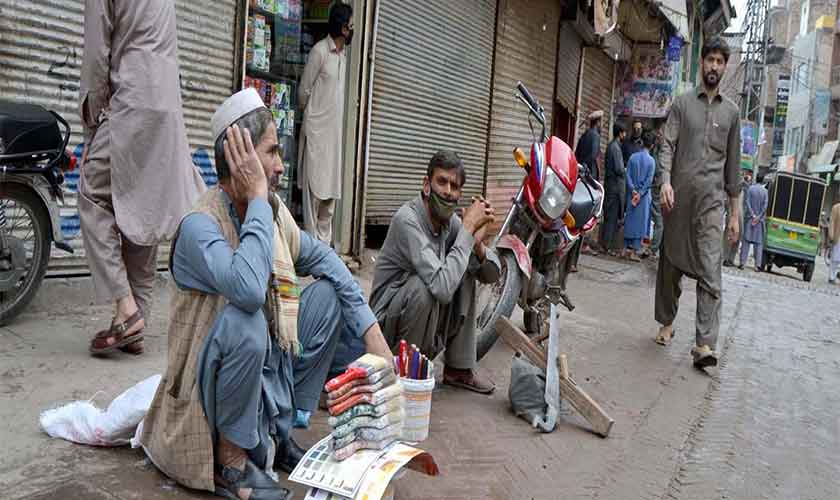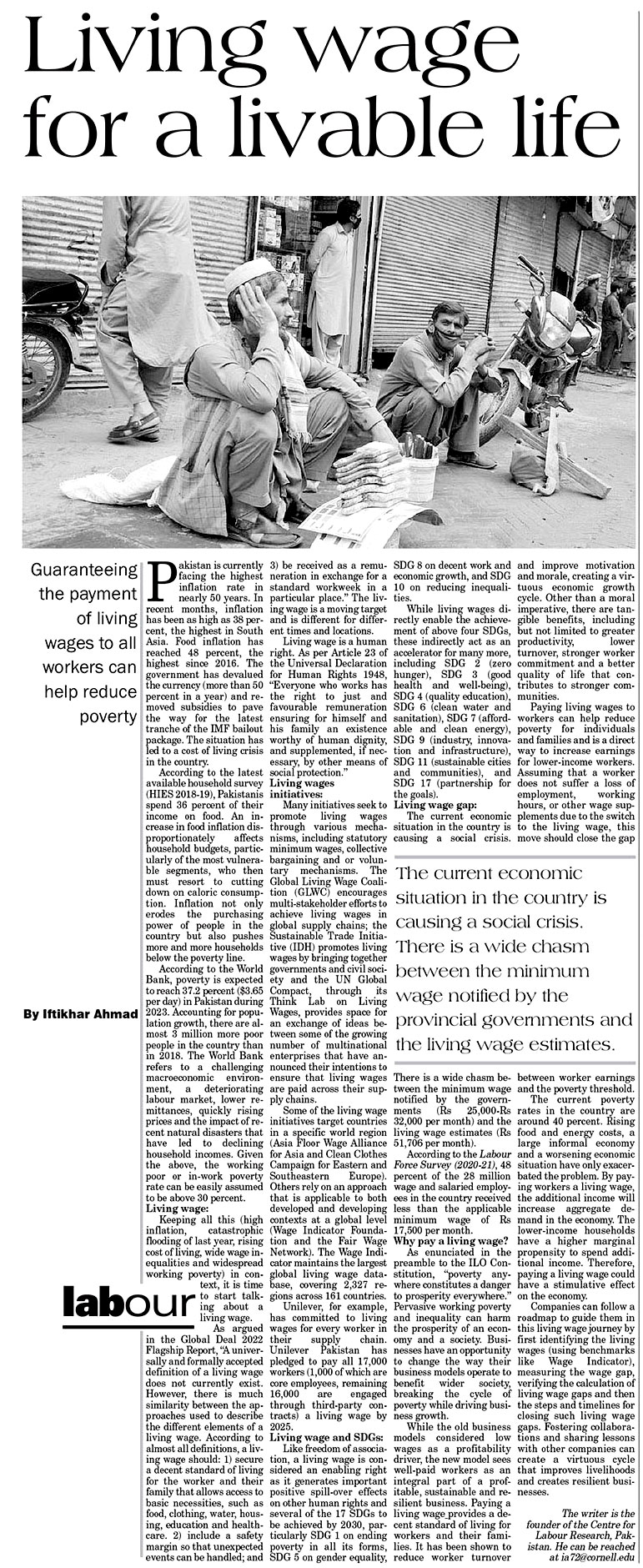
Living wage for a livable life
Pakistan is currently facing the highest inflation rate in nearly 50 years. In recent months, inflation has been as high as 38 percent, the highest in South Asia. Food inflation has reached 48 percent, the highest since 2016. The government has devalued the currency (more than 50 percent in a year) and removed subsidies to pave the way for the latest tranche of the IMF bailout package. The situation has led to a cost of living crisis in the country.
According to the latest available household survey (HIES 2018-19), Pakistanis spend 36 percent of their income on food. An increase in food inflation disproportionately affects household budgets, particularly of the most vulnerable segments, who then must resort to cutting down on caloric consumption. Inflation not only erodes the purchasing power of people in the country but also pushes more and more households below the poverty line.
According to the World Bank, poverty is expected to reach 37.2 percent ($3.65 per day) in Pakistan during 2023. Accounting for population growth, there are almost 3 million more poor people in the country than in 2018. The World Bank refers to a challenging macroeconomic environment, a deteriorating labour market, lower remittances, quickly rising prices and the impact of recent natural disasters that have led to declining household incomes. Given the above, the working poor or in-work poverty rate can be easily assumed to be above 30 percent.
Living wage:
Keeping all this (high inflation, catastrophic flooding of last year, rising cost of living, wide wage inequalities and widespread working poverty) in context, it is time to start talking about a living wage.
As argued in the Global Deal 2022 Flagship Report, “A universally and formally accepted definition of a living wage does not currently exist. However, there is much similarity between the approaches used to describe the different elements of a living wage. According to almost all definitions, a living wage should: 1) secure a decent standard of living for the worker and their family that allows access to basic necessities, such as food, clothing, water, housing, education and healthcare. 2) include a safety margin so that unexpected events can be handled; and 3) be received as a remuneration in exchange for a standard workweek in a particular place.” The living wage is a moving target and is different for different times and locations.
Living wage is a human right. As per Article 23 of the Universal Declaration for Human Rights 1948, “Everyone who works has the right to just and favourable remuneration ensuring for himself and his family an existence worthy of human dignity, and supplemented, if necessary, by other means of social protection.”
Living wages
initiatives:
Many initiatives seek to promote living wages through various mechanisms, including statutory minimum wages, collective bargaining and or voluntary mechanisms. The Global Living Wage Coalition (GLWC) encourages multi-stakeholder efforts to achieve living wages in global supply chains; the Sustainable Trade Initiative (IDH) promotes living wages by bringing together governments and civil society and the UN Global Compact, through its Think Lab on Living Wages, provides space for an exchange of ideas between some of the growing number of multinational enterprises that have announced their intentions to ensure that living wages are paid across their supply chains.
Some of the living wage initiatives target countries in a specific world region (Asia Floor Wage Alliance for Asia and Clean Clothes Campaign for Eastern and Southeastern Europe). Others rely on an approach that is applicable to both developed and developing contexts at a global level (Wage Indicator Foundation and the Fair Wage Network). The Wage Indicator maintains the largest global living wage database, covering 2,327 regions across 161 countries.
The current economic situation in the country is causing a social crisis. There is a wide chasm between the minimum wage notified by the provincial governments and the living wage estimates.
Unilever, for example, has committed to living wages for every worker in their supply chain. Unilever Pakistan has pledged to pay all 17,000 workers (1,000 of which are core employees, remaining 16,000 are engaged through third-party contracts) a living wage by 2025.
Living wage and SDGs:
Like freedom of association, a living wage is considered an enabling right as it generates important positive spill-over effects on other human rights and several of the 17 SDGs to be achieved by 2030, particularly SDG 1 on ending poverty in all its forms, SDG 5 on gender equality, SDG 8 on decent work and economic growth, and SDG 10 on reducing inequalities.
While living wages directly enable the achievement of above four SDGs, these indirectly act as an accelerator for many more, including SDG 2 (zero hunger), SDG 3 (good health and well-being), SDG 4 (quality education), SDG 6 (clean water and sanitation), SDG 7 (affordable and clean energy), SDG 9 (industry, innovation and infrastructure), SDG 11 (sustainable cities and communities), and SDG 17 (partnership for the goals).
Living wage gap:
The current economic situation in the country is causing a social crisis. There is a wide chasm between the minimum wage notified by the governments (Rs 25,000-Rs 32,000 per month) and the living wage estimates (Rs 51,706 per month).
According to the Labour Force Survey (2020-21), 48 percent of the 28 million wage and salaried employees in the country received less than the applicable minimum wage of Rs 17,500 per month.
Why pay a living wage?
As enunciated in the preamble to the ILO Constitution, “poverty anywhere constitutes a danger to prosperity everywhere.” Pervasive working poverty and inequality can harm the prosperity of an economy and a society. Businesses have an opportunity to change the way their business models operate to benefit wider society, breaking the cycle of poverty while driving business growth.
While the old business models considered low wages as a profitability driver, the new model sees well-paid workers as an integral part of a profitable, sustainable and resilient business. Paying a living wage provides a decent standard of living for workers and their families. It has been shown to reduce worker turnover and improve motivation and morale, creating a virtuous economic growth cycle. Other than a moral imperative, there are tangible benefits, including but not limited to greater productivity, lower turnover, stronger worker commitment and a better quality of life that contributes to stronger communities.
Paying living wages to workers can help reduce poverty for individuals and families and is a direct way to increase earnings for lower-income workers. Assuming that a worker does not suffer a loss of employment, working hours, or other wage supplements due to the switch to the living wage, this move should close the gap between worker earnings and the poverty threshold.
The current poverty rates in the country are around 40 percent. Rising food and energy costs, a large informal economy and a worsening economic situation have only exacerbated the problem. By paying workers a living wage, the additional income will increase aggregate demand in the economy. The lower-income households have a higher marginal propensity to spend additional income. Therefore, paying a living wage could have a stimulative effect on the economy.
Companies can follow a roadmap to guide them in this living wage journey by first identifying the living wages (using benchmarks like Wage Indicator), measuring the wage gap, verifying the calculation of living wage gaps and then the steps and timelines for closing such living wage gaps. Fostering collaborations and sharing lessons with other companies can create a virtuous cycle that improves livelihoods and creates resilient businesses.
This article was published in TNS here



